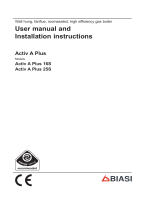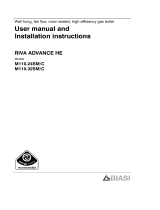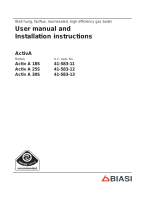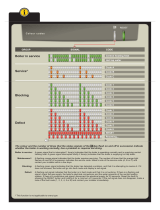
- 7 -
TABLE OF CONTENTS
1 APPLIANCE DESCRIPTION ............ 8
1.1 Overview............................... 8
1.2 Isolation valves .......................... 8
1.3 Controls panel .......................... 9
1.4 LCD general features .................... 10
2 INSTRUCTIONS FOR USE . . . . . . . . . . . . 12
2.1 Warnings.............................. 12
2.2 Relling procedure ...................... 12
2.3 Ignition ............................... 13
2.4 C.h. circuit temperature .................. 14
2.5 Extinguishing .......................... 15
3 USEFUL ADVICE.................... 16
3.1 Central Heating......................... 16
3.2 Frost protection......................... 16
3.3 Condensate drain ....................... 16
3.4 Periodic maintenance .................... 16
3.5 External cleaning ....................... 17
3.6 Operational faults ....................... 17
3.7 Displaying in INFO mode ................. 18
3.8 Remote anomaly code ................... 19
3.9 Flue probe ............................ 19
4 TECHNICAL INFORMATION........... 20
4.1 Overview.............................. 20
4.2 Main diagram .......................... 21
4.3 Hydraulic specications .................. 23
4.4 Expansion vessel ....................... 23
4.5 Technical data Advance Plus 16S .......... 24
4.6 Technical data Advance Plus 25S .......... 26
4.7 Technical data Advance Plus 30S .......... 28
5 GENERAL REQUIREMENTS .......... 30
5.1 Related documents...................... 30
5.2 Location of appliance .................... 30
5.3 Flue system ........................... 31
5.4 Gas supply ............................ 32
5.5 Air supply ............................. 32
5.6 Ventilation ............................. 32
5.7 Condensate drain ....................... 32
5.8 Water circulation (c.h.) ................... 33
5.9 Water treatment ........................ 34
5.10 Electrical supply ........................ 34
6 INSTALLATION ..................... 36
6.1 Warnings ............................. 36
6.2 Precautions for installation ................ 36
6.3 Installing the bracket..................... 37
6.4 Overall dimensions ...................... 38
6.5 Joints ................................ 38
6.6 Mounting the boiler ...................... 38
6.7 Fitting the ue system.................... 39
6.8 Choice of u ........................... 40
6.9 Electric connection ...................... 43
6.10 Connecting the room thermostat or zone valves 45
6.11 External frost protection .................. 46
6.12 Connecting a system boiler to a cylinder ..... 47
6.13 Installation of the external temperature probe
(optional).............................. 50
6.14 Electric connection between the boiler and the
external probe.......................... 50
6.15 Remote electric connection (optional) ....... 50
6.16 Example of hydraulic plants with hydraulic
separator ............................. 51
7 COMMISSIONING . . . . . . . . . . . . . . . . . . . 52
7.1 Warnings.............................. 52
7.2 Electrical installation ..................... 52
7.3 Gas supply installation ................... 52
7.4 Initial lling of the system ................. 52
7.5 Condensate pipe and traps ............... 54
7.6 Checking the gas supply pressure .......... 54
7.7 Checking the inlet pressure ............... 54
7.8 Lighting the boiler ....................... 55
7.9 Enabling functioning of the external
temperature probe by the remote control ..... 56
7.10 Setting the K coefcient of the external
temperature probe ...................... 57
7.11 Setting the pump post-circulation ........... 59
7.12 Selecting the reignition frequency .......... 61
7.13 Checking the ignition device ............... 63
7.14 Checking the ue system ................. 64
7.15 Checking the condensate drain pipe ........ 64
7.16 Instructing the user ...................... 64
7.17 Adjustment of useful c.h. output ............ 64
7.18 Setting record .......................... 66
8 GAS CONVERSION ................. 68
8.1 Warnings.............................. 68
8.2 Operations and gas setting................ 68
9 MAINTENANCE..................... 70
9.1 Warnings.............................. 70
9.2 Dismantling the external panels ............ 70
9.3 Reassembly the external panels ........... 71
9.4 Emptying the c.h. system ................. 71
9.5 Cleaning the condensing primary exchanger
and the burner ......................... 72
9.6 Check the pressure of the heating expansion
vessel . . . . . . . . . . . . . . . . . . . . . . . . . . . . . . . . 74
9.7 Checking the ue expulsion pipe ........... 74
9.8 Combustion analysis check ............... 74
9.9 Checking the condensate drain pipe ........ 75
9.10 Visual inspection of appliance ............. 75
9.11 Checking the gas supply pressure .......... 75
9.12 Water inhibitor concentration .............. 75
9.13 Setting the boiler chimney sweep function .... 76
Gas boiler system commissioning check-
list ............................... 78
Service record ..................... 79
Appliance category: II2H3P (gas G20 20 mbar, G31 37 mbar)
Country of destination: United Kingdom (GB) Ireland (IE)
This appliance conforms with the following EEC directive:
Gas Directive 2009/142/CE
Boiler Efciency Directive 92/42/CEE
Electromagnetic Compatibility Directive 2004/108/CE
Low Voltage Directive 2006/95/CE
The manufacturer, in the continuous process to improve his products, reserves the right to modify the data expressed
in the present documentation at any time and without prior notice.
The present documentation is an informative support and it can not be considered as a contract to-wards third parties.




























